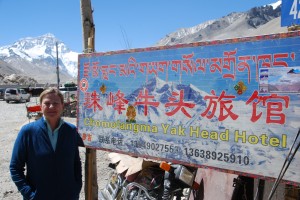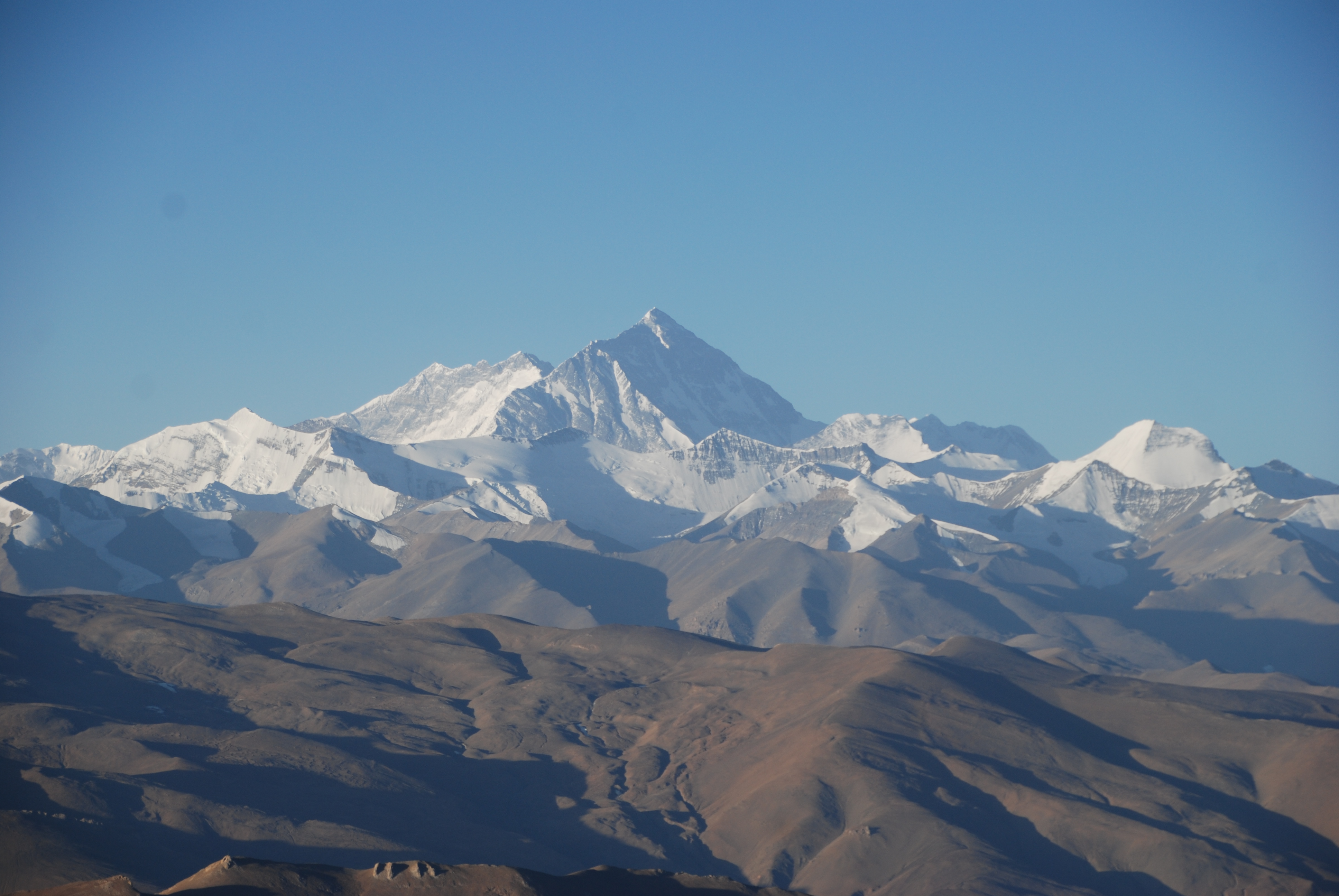Qomolangma!
The British called it Everest after a renown surveyor, the Nepalis refer to it as Sagarmatha and the Nepali Sherpas call it Chomolungma but the Tibetans call it Qomolangma. Since only one of those names is pronounceable we decided to stick to the global convention of Mt. Everest. By any name it stands above all other mountains, an imposing 8,848 metres, king of the Himalayas. And we were standing on a remote mountain ridge at over 5,100 metres watching the sun rise on Everest’s northern-eastern flanks, an unforgettable experience.
Spectacular sunrises in the Himalayas don’t come easy. We woke at 5am and the nighttime drive took us off-road for the first time, a slow dusty mountain road that started winding up the invisible mountain after yet another mindless security check. Back and forth the track went, dozens of switchbacks helped us climb higher and higher, a bit scary in the dark and at speed to keep our diesel engine at high pitch.
But finally we hit the top of the Pang La Pass at 5,120 metres. Laying out before us was one of the most stunning skylines possible. A series of snow covered peaks spread out on the horizon, starting from the east Mt. Makalu (8,463 metres), Mt. Lhotse (8,546), Mt. Everest (8,848) and Cho Oyo (8,201) plus many other lesser peaks. It is said that nowhere else in the world can one see four peaks over 8,000 metres all at once. And we were there.
We took countless photos and hours of video while the sun rose in this cloudless sky and the light got stronger, revelling in this special moment despite its zero degree temperature and rising breeze. After being interviewed by Chinese television for our thoughts on how fantastic China is, we reluctantly tracked down the other side, another series of tight switchbacks to get us down into the valley, a spray of dust following us everywhere.
As it happens, one of Kelsang’s sisters live in a small village on the track to Everest Base Camp. So of course we had to pull in to their family home and have more yak butter tea. This was a special treat in a plain but cosy family home, enjoying warm hospitality in another language while desperately trying to avoid the tea. Great stuff (the visit, not the tea).
We followed the rough washboard track for a couple of hours, passing through remote forlorn villages and steep mountain slopes until our slow climb brought us back in view of Everest, looming closer with every turn. This is dusty desolate country, wild and forgotten with very few signs of any life and a strong wind to make it worse. The track eventually came to the Rongbuk Monastery, at 5,000 metres said to be the highest monastery in the world.

Julie and Everest outside our tent for the night. The sign overstates it as the Chomolungma Yak Head Hotel
After a quick look at this 8th century temple – what would this place have been like 1,200 years ago? – we moved on to a tent camp which was the end of the road and our home for the night. Our yak hair tent was warm and roomy with a stove in the middle, plenty of space for the four of us to eat, socialise and sleep tonight. And they immediately served up a great bowl of fried noodles and spicy soup, perfect for the occasion.
But the big event of the day was still ahead of us – walking from the tent camp about four kilometres up the valley to Everest Base Camp. Yes, you can pay money and take a private shuttle bus but of course we had to walk (and were the only ones we saw all day to make the trek). So off we went, following Kelsang with the mighty north face of Everest looming high above us.
This walk followed the dirt road for a short while, then tracked on the frequent yak trails that scattered the slope (and we ran into multiple herds of yaks along the way) and plain old bush-bashing, or in this case, rock-bashing as we followed the ancient rocky watercourse and glacial melt river beside us. The climb over the four kilometres was only 100 metres in elevation gain but as our final destination was 5,200 metres this meant a very slow and steady plodding walk with many rest stops, desperately trying to give our bodies a chance to deal with the extremely high altitude and lack of oxygen. With temperatures in the low 20’s and a bright glare that drained us we had a full task on our hands (and lungs).
Eventually we made it to the final ridge. Spread out before us was the massive Mt. Everest, now with a few clouds slowly moving into position, glaciers at lower levels and glacial moraine spilling below them. Below the moraine was what seemed to be the camps of four teams of Everest climbers, housed in their bright coloured tents, supporting their climbing teams far above. May is peak climbing season and we all had a quiet wish for the climbers’ good fortune, whether they are going up or coming down.
We took many many photos of course and Julie also hung a prayer flag with all our family and friend’s names written on it, wishing all safe travels, good health and long life. The wind start blowing harder and it was time to retreat down the mountain to the relative comfort (read: no wind, dust or glaring sun) of our yak tent.
Life in the tent camp was a bit grim. The cold wind blew hard which meant blinding dust swirled everywhere, made worse by numerous 4WDs and motor bikes constantly coming and going. But the views around us were stunning as the sun got lower on the mountains and eventually set on the Big Boy.
There was some angst on our team as Pemba had to turn bush mechanic and replace all of our shock absorbers (no surprise given the roads and the age of our vessel) but under some challenging conditions he managed to pull it off. This must have been quite difficult and was his finest hour.
The toilet facilities at the tent camp were made up of the most basic shed with squat and shoot technology. But what we have noticed with the locals is that going to the toilet is not a personal issue, its not a privacy issue and its not even really a hygiene issue. They treat the whole process as simply a disposal issue. They have something they don’t want and they dispose of it, anywhere they want, any time they want and under any circumstances they face. Both men and women will openly go about their disposal business as it suits them, in the open and in the cold. I don’t think it will catch on at home.
Before dark we were joined in our tent by nine local nomadic herders and farmers plus one little baby. These six men and three women sat down, were immediately offered yak butter tea by our young host and seemed to settle in for the night. We were fascinated by these people in their hard worn traditional dress, unwashed face and hands, totally unkempt hair, toothless grins and the social order between them. We were served our bowl of noodles for dinner and they found this the best entertainment in years. They were then served a big bowl of soup and noodles, battled with the chop sticks a bit, but ate quickly with not much chatter between them.
The women looked haggard and worn but still struck a feminine pose with their long braided hair, skirts and aprons (which indicated they were all married). The men were more shabbily dressed, hair knotted and dirty, clothes filthy and unkempt, a glaze in their eyes which said they were uncertain of their situation.
After dinner the men picked up their tattered bags of worldly possessions, walked out of the tent into the dark and zero degree weather, not to be seen again. The three women and the baby disappeared into the adjoining cooking tent where we were told they would spend the night. Of their past and their futures we can only speculate.
The communal sleeping around the stove for the remaining four of us was cosy and warm as we climbed under the heavy blankets in our full clothes and tried to fall asleep at this high altitude where oxygen and normal breathing are in short supply.
But what a day, enjoying a spectacular sunrise over the Himalayas followed by a wonderful and personally rewarding trek to Everest Base Camp for spectacular views of the highest mountain in the world. Call it Qomolangma or Everest or anything you like, it reigns supreme and so has this outstanding day.
















